Operations & Project Management: Analysis and Improvement Plan
VerifiedAdded on 2023/06/18
|21
|5382
|352
Report
AI Summary
This report provides a comprehensive analysis of operations and project management principles, focusing on a case study of Tesco and an on-site catering project. Part 1 delves into the distinction between operation and operations management, reviews the implementation of operations management principles within Tesco, and analyzes the extent to which Tesco's operations management meets organizational requirements. It further discusses continuous improvement as a philosophy, describes Lean principles, and proposes a continuous improvement plan with justified recommendations. Part 2 centers on an on-site catering project, providing an overview of the case study and explaining each stage of the project lifecycle (PLC) with supporting documentation. The report analyzes the project methodologies and tools used, and critically evaluates the effectiveness of the PLC in application to the project, utilizing appropriate theories, models, and concepts. The report concludes by highlighting the importance of operation management in ensuring product quality and customer satisfaction.
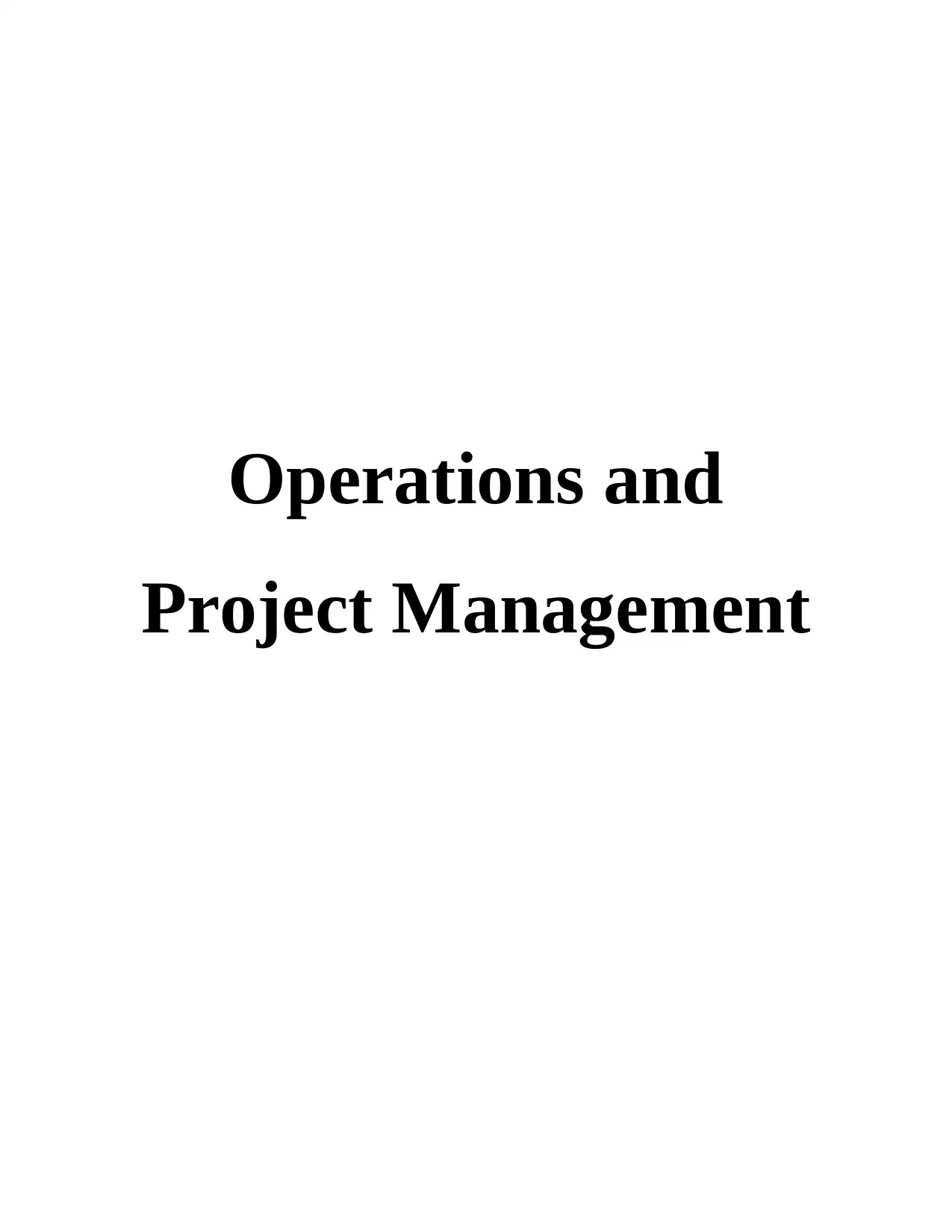
Operations and
Project Management
Project Management
Paraphrase This Document
Need a fresh take? Get an instant paraphrase of this document with our AI Paraphraser
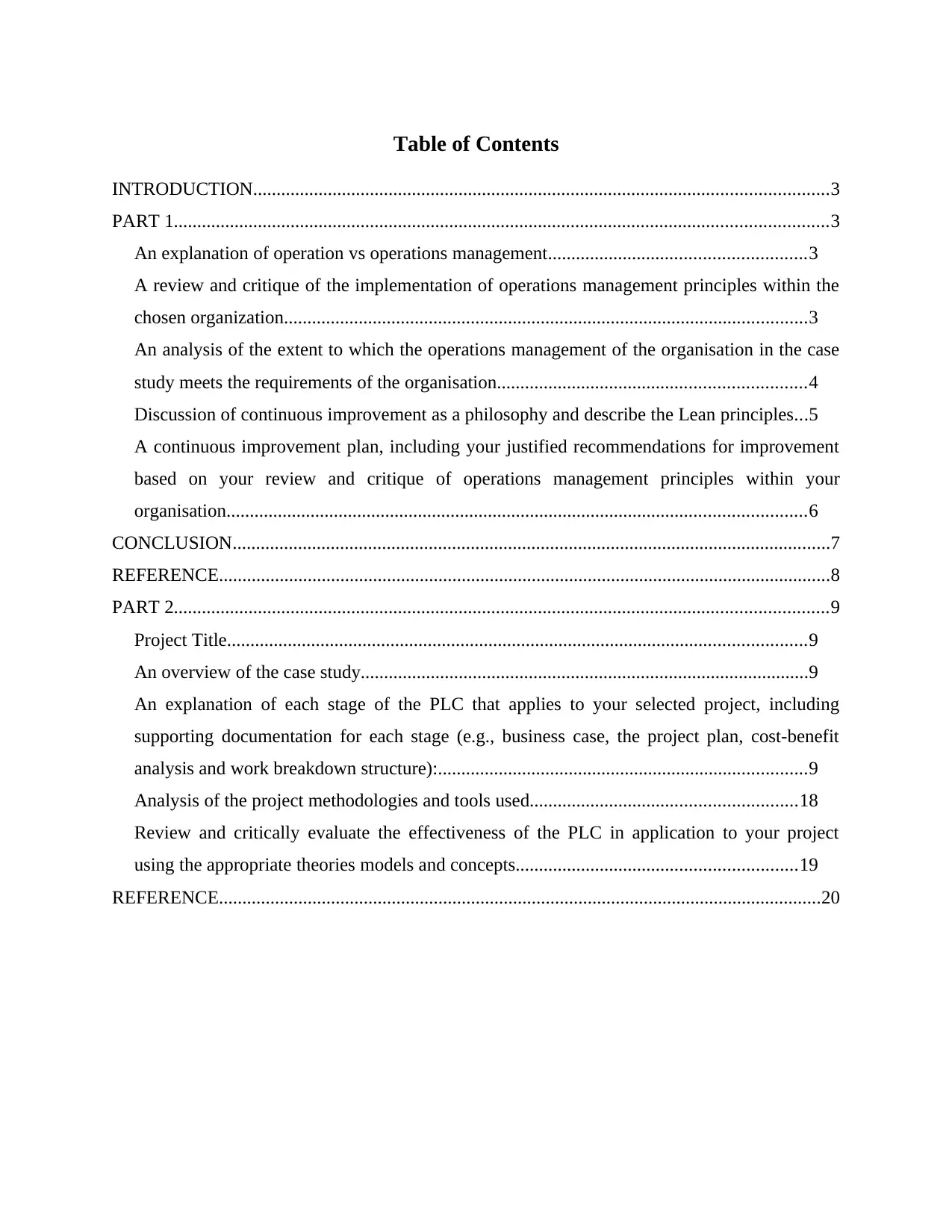
Table of Contents
INTRODUCTION...........................................................................................................................3
PART 1............................................................................................................................................3
An explanation of operation vs operations management.......................................................3
A review and critique of the implementation of operations management principles within the
chosen organization................................................................................................................3
An analysis of the extent to which the operations management of the organisation in the case
study meets the requirements of the organisation..................................................................4
Discussion of continuous improvement as a philosophy and describe the Lean principles...5
A continuous improvement plan, including your justified recommendations for improvement
based on your review and critique of operations management principles within your
organisation............................................................................................................................6
CONCLUSION................................................................................................................................7
REFERENCE...................................................................................................................................8
PART 2............................................................................................................................................9
Project Title............................................................................................................................9
An overview of the case study................................................................................................9
An explanation of each stage of the PLC that applies to your selected project, including
supporting documentation for each stage (e.g., business case, the project plan, cost-benefit
analysis and work breakdown structure):...............................................................................9
Analysis of the project methodologies and tools used.........................................................18
Review and critically evaluate the effectiveness of the PLC in application to your project
using the appropriate theories models and concepts............................................................19
REFERENCE.................................................................................................................................20
INTRODUCTION...........................................................................................................................3
PART 1............................................................................................................................................3
An explanation of operation vs operations management.......................................................3
A review and critique of the implementation of operations management principles within the
chosen organization................................................................................................................3
An analysis of the extent to which the operations management of the organisation in the case
study meets the requirements of the organisation..................................................................4
Discussion of continuous improvement as a philosophy and describe the Lean principles...5
A continuous improvement plan, including your justified recommendations for improvement
based on your review and critique of operations management principles within your
organisation............................................................................................................................6
CONCLUSION................................................................................................................................7
REFERENCE...................................................................................................................................8
PART 2............................................................................................................................................9
Project Title............................................................................................................................9
An overview of the case study................................................................................................9
An explanation of each stage of the PLC that applies to your selected project, including
supporting documentation for each stage (e.g., business case, the project plan, cost-benefit
analysis and work breakdown structure):...............................................................................9
Analysis of the project methodologies and tools used.........................................................18
Review and critically evaluate the effectiveness of the PLC in application to your project
using the appropriate theories models and concepts............................................................19
REFERENCE.................................................................................................................................20
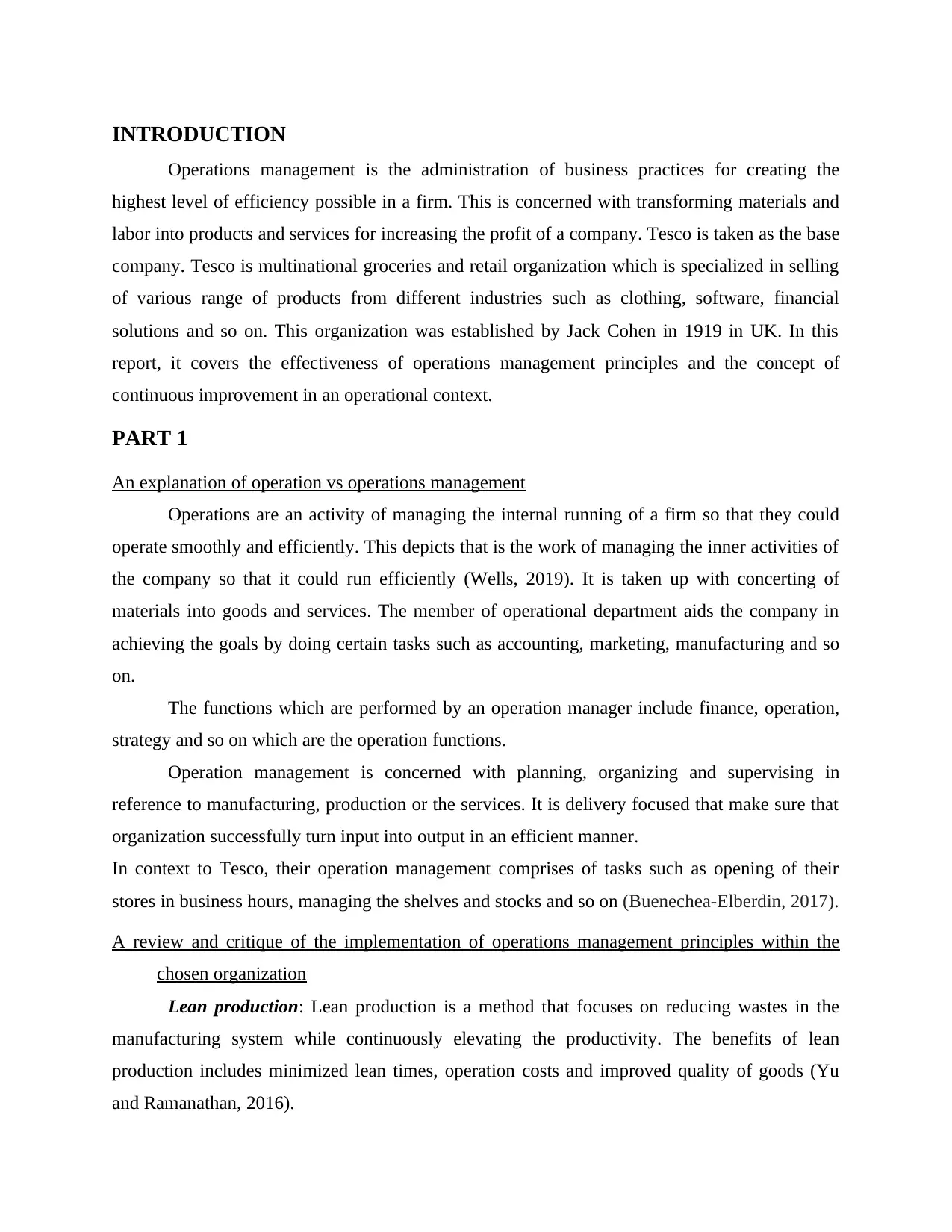
INTRODUCTION
Operations management is the administration of business practices for creating the
highest level of efficiency possible in a firm. This is concerned with transforming materials and
labor into products and services for increasing the profit of a company. Tesco is taken as the base
company. Tesco is multinational groceries and retail organization which is specialized in selling
of various range of products from different industries such as clothing, software, financial
solutions and so on. This organization was established by Jack Cohen in 1919 in UK. In this
report, it covers the effectiveness of operations management principles and the concept of
continuous improvement in an operational context.
PART 1
An explanation of operation vs operations management
Operations are an activity of managing the internal running of a firm so that they could
operate smoothly and efficiently. This depicts that is the work of managing the inner activities of
the company so that it could run efficiently (Wells, 2019). It is taken up with concerting of
materials into goods and services. The member of operational department aids the company in
achieving the goals by doing certain tasks such as accounting, marketing, manufacturing and so
on.
The functions which are performed by an operation manager include finance, operation,
strategy and so on which are the operation functions.
Operation management is concerned with planning, organizing and supervising in
reference to manufacturing, production or the services. It is delivery focused that make sure that
organization successfully turn input into output in an efficient manner.
In context to Tesco, their operation management comprises of tasks such as opening of their
stores in business hours, managing the shelves and stocks and so on (Buenechea-Elberdin, 2017).
A review and critique of the implementation of operations management principles within the
chosen organization
Lean production: Lean production is a method that focuses on reducing wastes in the
manufacturing system while continuously elevating the productivity. The benefits of lean
production includes minimized lean times, operation costs and improved quality of goods (Yu
and Ramanathan, 2016).
Operations management is the administration of business practices for creating the
highest level of efficiency possible in a firm. This is concerned with transforming materials and
labor into products and services for increasing the profit of a company. Tesco is taken as the base
company. Tesco is multinational groceries and retail organization which is specialized in selling
of various range of products from different industries such as clothing, software, financial
solutions and so on. This organization was established by Jack Cohen in 1919 in UK. In this
report, it covers the effectiveness of operations management principles and the concept of
continuous improvement in an operational context.
PART 1
An explanation of operation vs operations management
Operations are an activity of managing the internal running of a firm so that they could
operate smoothly and efficiently. This depicts that is the work of managing the inner activities of
the company so that it could run efficiently (Wells, 2019). It is taken up with concerting of
materials into goods and services. The member of operational department aids the company in
achieving the goals by doing certain tasks such as accounting, marketing, manufacturing and so
on.
The functions which are performed by an operation manager include finance, operation,
strategy and so on which are the operation functions.
Operation management is concerned with planning, organizing and supervising in
reference to manufacturing, production or the services. It is delivery focused that make sure that
organization successfully turn input into output in an efficient manner.
In context to Tesco, their operation management comprises of tasks such as opening of their
stores in business hours, managing the shelves and stocks and so on (Buenechea-Elberdin, 2017).
A review and critique of the implementation of operations management principles within the
chosen organization
Lean production: Lean production is a method that focuses on reducing wastes in the
manufacturing system while continuously elevating the productivity. The benefits of lean
production includes minimized lean times, operation costs and improved quality of goods (Yu
and Ramanathan, 2016).
⊘ This is a preview!⊘
Do you want full access?
Subscribe today to unlock all pages.

Trusted by 1+ million students worldwide
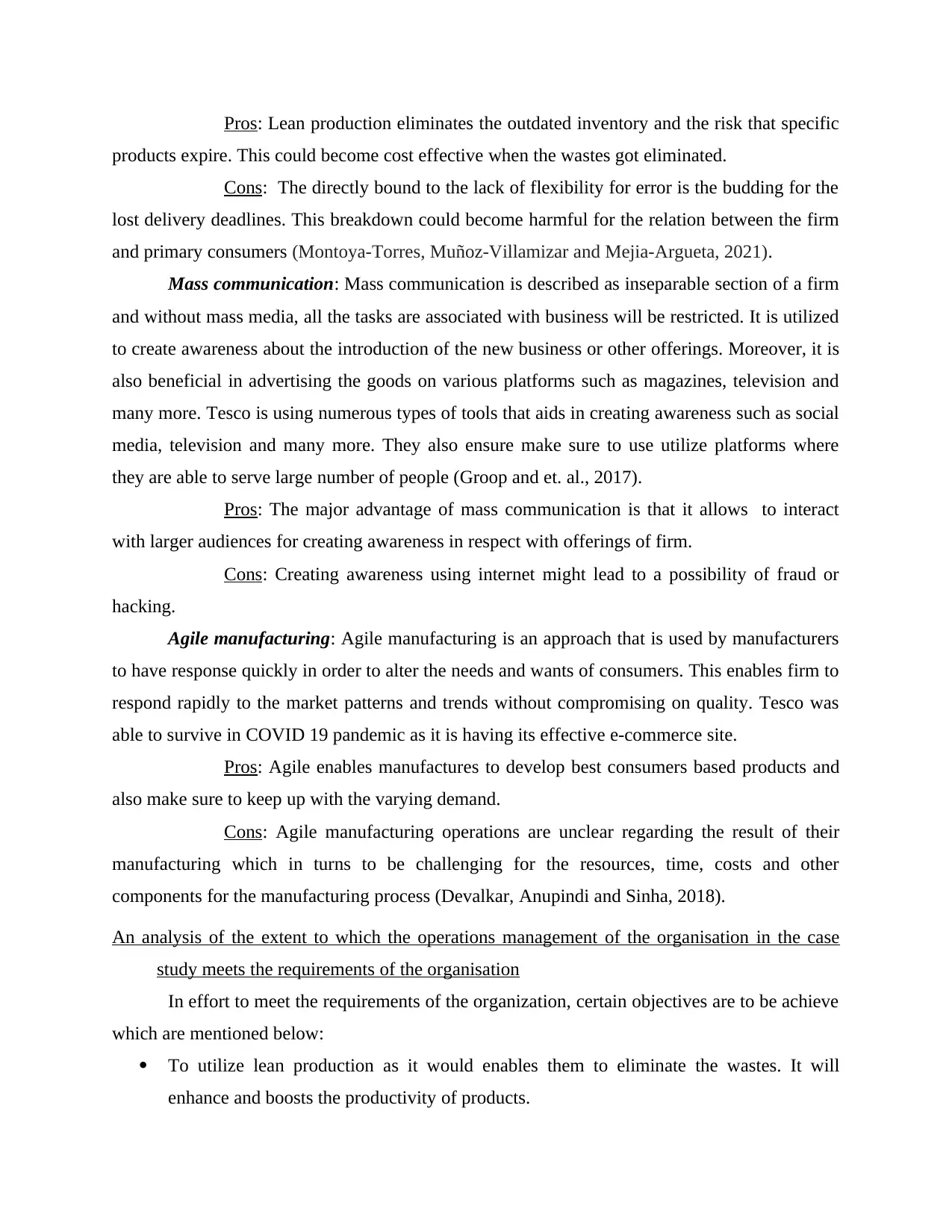
Pros: Lean production eliminates the outdated inventory and the risk that specific
products expire. This could become cost effective when the wastes got eliminated.
Cons: The directly bound to the lack of flexibility for error is the budding for the
lost delivery deadlines. This breakdown could become harmful for the relation between the firm
and primary consumers (Montoya-Torres, Muñoz-Villamizar and Mejia-Argueta, 2021).
Mass communication: Mass communication is described as inseparable section of a firm
and without mass media, all the tasks are associated with business will be restricted. It is utilized
to create awareness about the introduction of the new business or other offerings. Moreover, it is
also beneficial in advertising the goods on various platforms such as magazines, television and
many more. Tesco is using numerous types of tools that aids in creating awareness such as social
media, television and many more. They also ensure make sure to use utilize platforms where
they are able to serve large number of people (Groop and et. al., 2017).
Pros: The major advantage of mass communication is that it allows to interact
with larger audiences for creating awareness in respect with offerings of firm.
Cons: Creating awareness using internet might lead to a possibility of fraud or
hacking.
Agile manufacturing: Agile manufacturing is an approach that is used by manufacturers
to have response quickly in order to alter the needs and wants of consumers. This enables firm to
respond rapidly to the market patterns and trends without compromising on quality. Tesco was
able to survive in COVID 19 pandemic as it is having its effective e-commerce site.
Pros: Agile enables manufactures to develop best consumers based products and
also make sure to keep up with the varying demand.
Cons: Agile manufacturing operations are unclear regarding the result of their
manufacturing which in turns to be challenging for the resources, time, costs and other
components for the manufacturing process (Devalkar, Anupindi and Sinha, 2018).
An analysis of the extent to which the operations management of the organisation in the case
study meets the requirements of the organisation
In effort to meet the requirements of the organization, certain objectives are to be achieve
which are mentioned below:
To utilize lean production as it would enables them to eliminate the wastes. It will
enhance and boosts the productivity of products.
products expire. This could become cost effective when the wastes got eliminated.
Cons: The directly bound to the lack of flexibility for error is the budding for the
lost delivery deadlines. This breakdown could become harmful for the relation between the firm
and primary consumers (Montoya-Torres, Muñoz-Villamizar and Mejia-Argueta, 2021).
Mass communication: Mass communication is described as inseparable section of a firm
and without mass media, all the tasks are associated with business will be restricted. It is utilized
to create awareness about the introduction of the new business or other offerings. Moreover, it is
also beneficial in advertising the goods on various platforms such as magazines, television and
many more. Tesco is using numerous types of tools that aids in creating awareness such as social
media, television and many more. They also ensure make sure to use utilize platforms where
they are able to serve large number of people (Groop and et. al., 2017).
Pros: The major advantage of mass communication is that it allows to interact
with larger audiences for creating awareness in respect with offerings of firm.
Cons: Creating awareness using internet might lead to a possibility of fraud or
hacking.
Agile manufacturing: Agile manufacturing is an approach that is used by manufacturers
to have response quickly in order to alter the needs and wants of consumers. This enables firm to
respond rapidly to the market patterns and trends without compromising on quality. Tesco was
able to survive in COVID 19 pandemic as it is having its effective e-commerce site.
Pros: Agile enables manufactures to develop best consumers based products and
also make sure to keep up with the varying demand.
Cons: Agile manufacturing operations are unclear regarding the result of their
manufacturing which in turns to be challenging for the resources, time, costs and other
components for the manufacturing process (Devalkar, Anupindi and Sinha, 2018).
An analysis of the extent to which the operations management of the organisation in the case
study meets the requirements of the organisation
In effort to meet the requirements of the organization, certain objectives are to be achieve
which are mentioned below:
To utilize lean production as it would enables them to eliminate the wastes. It will
enhance and boosts the productivity of products.
Paraphrase This Document
Need a fresh take? Get an instant paraphrase of this document with our AI Paraphraser
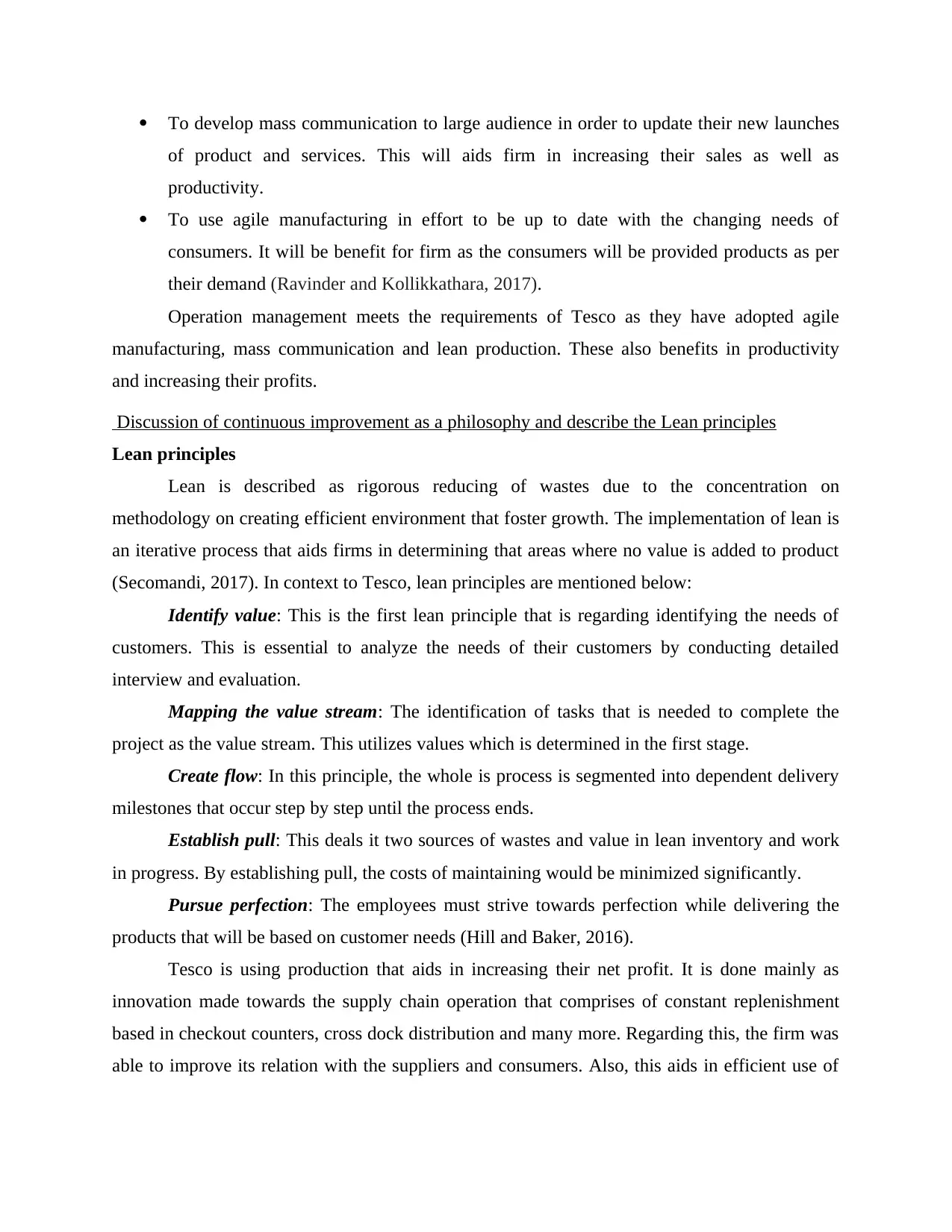
To develop mass communication to large audience in order to update their new launches
of product and services. This will aids firm in increasing their sales as well as
productivity.
To use agile manufacturing in effort to be up to date with the changing needs of
consumers. It will be benefit for firm as the consumers will be provided products as per
their demand (Ravinder and Kollikkathara, 2017).
Operation management meets the requirements of Tesco as they have adopted agile
manufacturing, mass communication and lean production. These also benefits in productivity
and increasing their profits.
Discussion of continuous improvement as a philosophy and describe the Lean principles
Lean principles
Lean is described as rigorous reducing of wastes due to the concentration on
methodology on creating efficient environment that foster growth. The implementation of lean is
an iterative process that aids firms in determining that areas where no value is added to product
(Secomandi, 2017). In context to Tesco, lean principles are mentioned below:
Identify value: This is the first lean principle that is regarding identifying the needs of
customers. This is essential to analyze the needs of their customers by conducting detailed
interview and evaluation.
Mapping the value stream: The identification of tasks that is needed to complete the
project as the value stream. This utilizes values which is determined in the first stage.
Create flow: In this principle, the whole is process is segmented into dependent delivery
milestones that occur step by step until the process ends.
Establish pull: This deals it two sources of wastes and value in lean inventory and work
in progress. By establishing pull, the costs of maintaining would be minimized significantly.
Pursue perfection: The employees must strive towards perfection while delivering the
products that will be based on customer needs (Hill and Baker, 2016).
Tesco is using production that aids in increasing their net profit. It is done mainly as
innovation made towards the supply chain operation that comprises of constant replenishment
based in checkout counters, cross dock distribution and many more. Regarding this, the firm was
able to improve its relation with the suppliers and consumers. Also, this aids in efficient use of
of product and services. This will aids firm in increasing their sales as well as
productivity.
To use agile manufacturing in effort to be up to date with the changing needs of
consumers. It will be benefit for firm as the consumers will be provided products as per
their demand (Ravinder and Kollikkathara, 2017).
Operation management meets the requirements of Tesco as they have adopted agile
manufacturing, mass communication and lean production. These also benefits in productivity
and increasing their profits.
Discussion of continuous improvement as a philosophy and describe the Lean principles
Lean principles
Lean is described as rigorous reducing of wastes due to the concentration on
methodology on creating efficient environment that foster growth. The implementation of lean is
an iterative process that aids firms in determining that areas where no value is added to product
(Secomandi, 2017). In context to Tesco, lean principles are mentioned below:
Identify value: This is the first lean principle that is regarding identifying the needs of
customers. This is essential to analyze the needs of their customers by conducting detailed
interview and evaluation.
Mapping the value stream: The identification of tasks that is needed to complete the
project as the value stream. This utilizes values which is determined in the first stage.
Create flow: In this principle, the whole is process is segmented into dependent delivery
milestones that occur step by step until the process ends.
Establish pull: This deals it two sources of wastes and value in lean inventory and work
in progress. By establishing pull, the costs of maintaining would be minimized significantly.
Pursue perfection: The employees must strive towards perfection while delivering the
products that will be based on customer needs (Hill and Baker, 2016).
Tesco is using production that aids in increasing their net profit. It is done mainly as
innovation made towards the supply chain operation that comprises of constant replenishment
based in checkout counters, cross dock distribution and many more. Regarding this, the firm was
able to improve its relation with the suppliers and consumers. Also, this aids in efficient use of
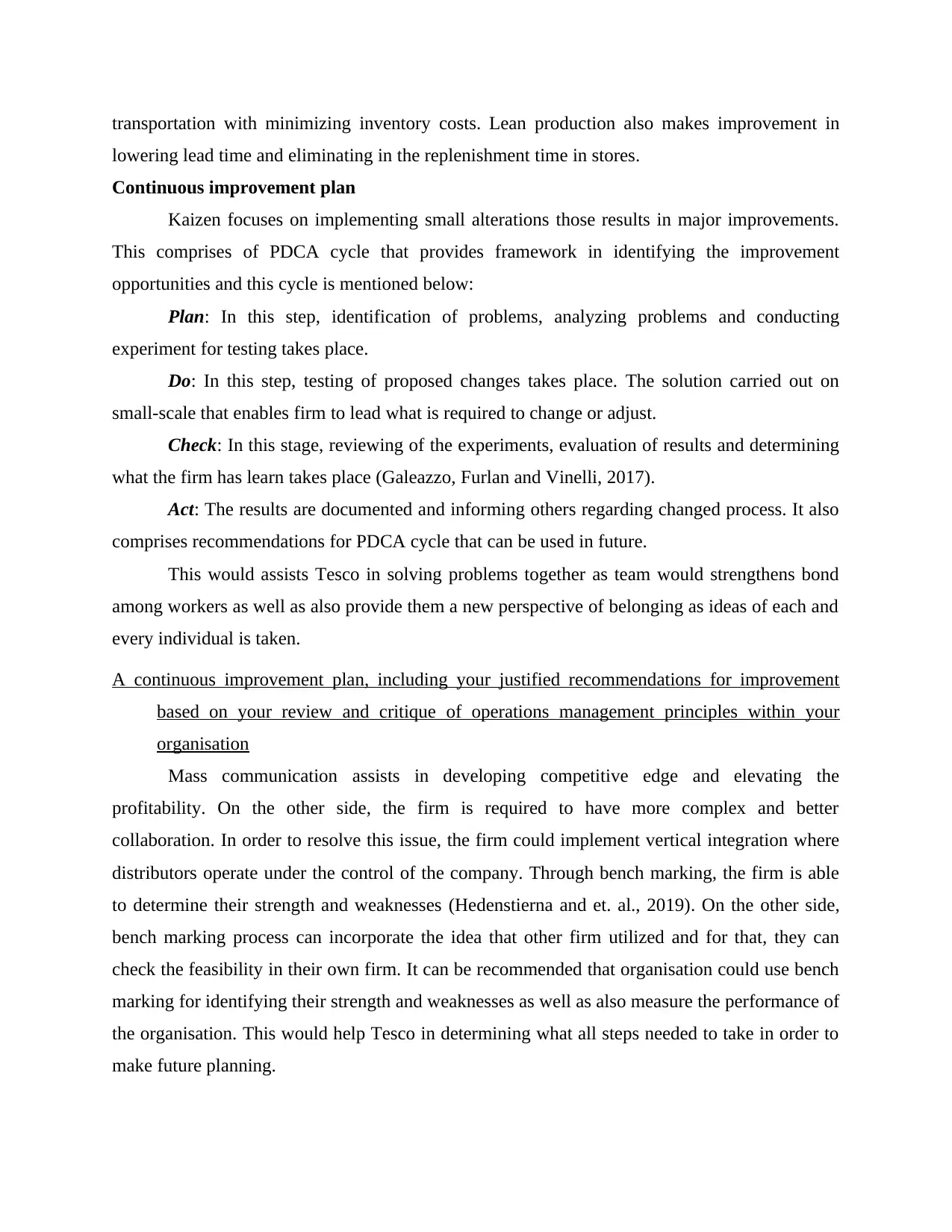
transportation with minimizing inventory costs. Lean production also makes improvement in
lowering lead time and eliminating in the replenishment time in stores.
Continuous improvement plan
Kaizen focuses on implementing small alterations those results in major improvements.
This comprises of PDCA cycle that provides framework in identifying the improvement
opportunities and this cycle is mentioned below:
Plan: In this step, identification of problems, analyzing problems and conducting
experiment for testing takes place.
Do: In this step, testing of proposed changes takes place. The solution carried out on
small-scale that enables firm to lead what is required to change or adjust.
Check: In this stage, reviewing of the experiments, evaluation of results and determining
what the firm has learn takes place (Galeazzo, Furlan and Vinelli, 2017).
Act: The results are documented and informing others regarding changed process. It also
comprises recommendations for PDCA cycle that can be used in future.
This would assists Tesco in solving problems together as team would strengthens bond
among workers as well as also provide them a new perspective of belonging as ideas of each and
every individual is taken.
A continuous improvement plan, including your justified recommendations for improvement
based on your review and critique of operations management principles within your
organisation
Mass communication assists in developing competitive edge and elevating the
profitability. On the other side, the firm is required to have more complex and better
collaboration. In order to resolve this issue, the firm could implement vertical integration where
distributors operate under the control of the company. Through bench marking, the firm is able
to determine their strength and weaknesses (Hedenstierna and et. al., 2019). On the other side,
bench marking process can incorporate the idea that other firm utilized and for that, they can
check the feasibility in their own firm. It can be recommended that organisation could use bench
marking for identifying their strength and weaknesses as well as also measure the performance of
the organisation. This would help Tesco in determining what all steps needed to take in order to
make future planning.
lowering lead time and eliminating in the replenishment time in stores.
Continuous improvement plan
Kaizen focuses on implementing small alterations those results in major improvements.
This comprises of PDCA cycle that provides framework in identifying the improvement
opportunities and this cycle is mentioned below:
Plan: In this step, identification of problems, analyzing problems and conducting
experiment for testing takes place.
Do: In this step, testing of proposed changes takes place. The solution carried out on
small-scale that enables firm to lead what is required to change or adjust.
Check: In this stage, reviewing of the experiments, evaluation of results and determining
what the firm has learn takes place (Galeazzo, Furlan and Vinelli, 2017).
Act: The results are documented and informing others regarding changed process. It also
comprises recommendations for PDCA cycle that can be used in future.
This would assists Tesco in solving problems together as team would strengthens bond
among workers as well as also provide them a new perspective of belonging as ideas of each and
every individual is taken.
A continuous improvement plan, including your justified recommendations for improvement
based on your review and critique of operations management principles within your
organisation
Mass communication assists in developing competitive edge and elevating the
profitability. On the other side, the firm is required to have more complex and better
collaboration. In order to resolve this issue, the firm could implement vertical integration where
distributors operate under the control of the company. Through bench marking, the firm is able
to determine their strength and weaknesses (Hedenstierna and et. al., 2019). On the other side,
bench marking process can incorporate the idea that other firm utilized and for that, they can
check the feasibility in their own firm. It can be recommended that organisation could use bench
marking for identifying their strength and weaknesses as well as also measure the performance of
the organisation. This would help Tesco in determining what all steps needed to take in order to
make future planning.
⊘ This is a preview!⊘
Do you want full access?
Subscribe today to unlock all pages.

Trusted by 1+ million students worldwide
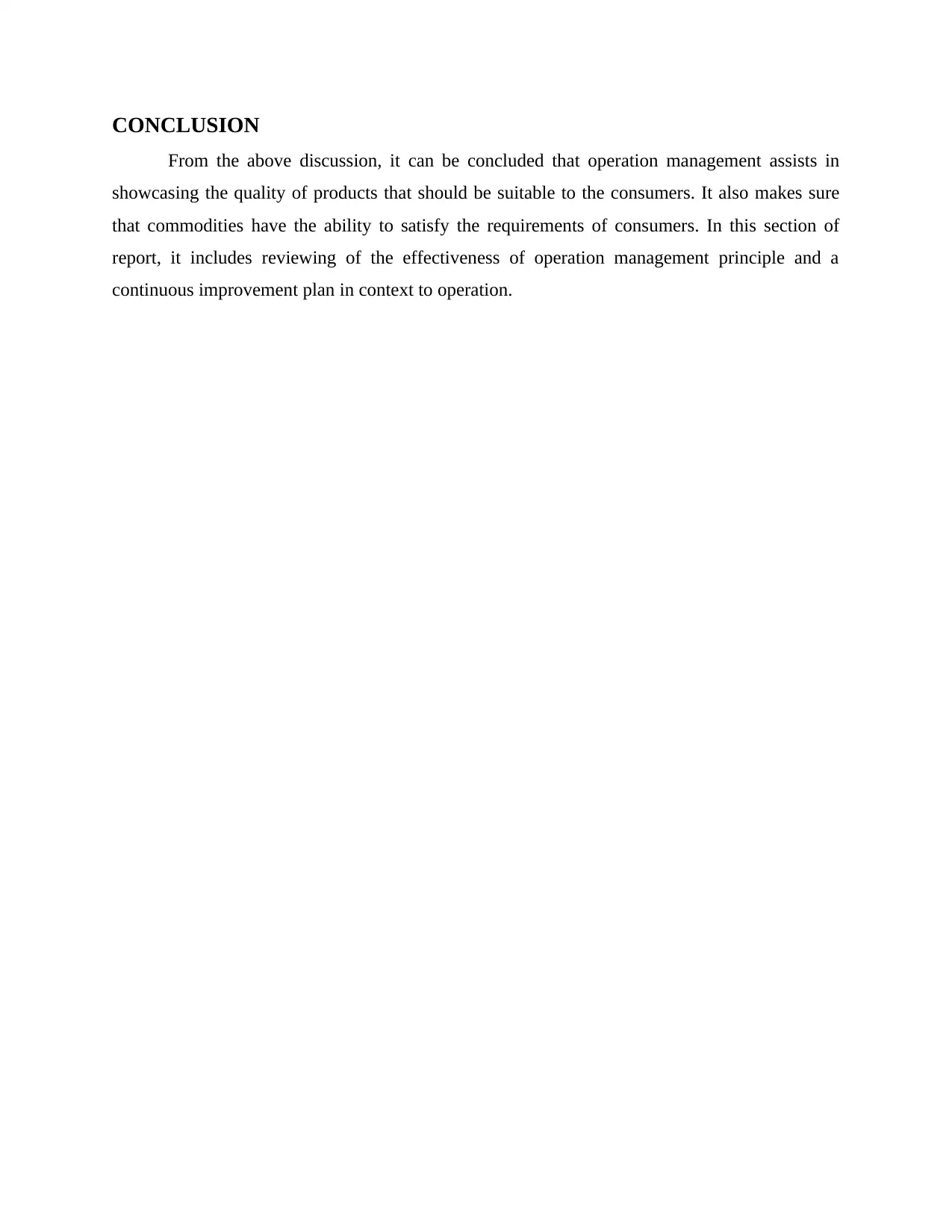
CONCLUSION
From the above discussion, it can be concluded that operation management assists in
showcasing the quality of products that should be suitable to the consumers. It also makes sure
that commodities have the ability to satisfy the requirements of consumers. In this section of
report, it includes reviewing of the effectiveness of operation management principle and a
continuous improvement plan in context to operation.
From the above discussion, it can be concluded that operation management assists in
showcasing the quality of products that should be suitable to the consumers. It also makes sure
that commodities have the ability to satisfy the requirements of consumers. In this section of
report, it includes reviewing of the effectiveness of operation management principle and a
continuous improvement plan in context to operation.
Paraphrase This Document
Need a fresh take? Get an instant paraphrase of this document with our AI Paraphraser
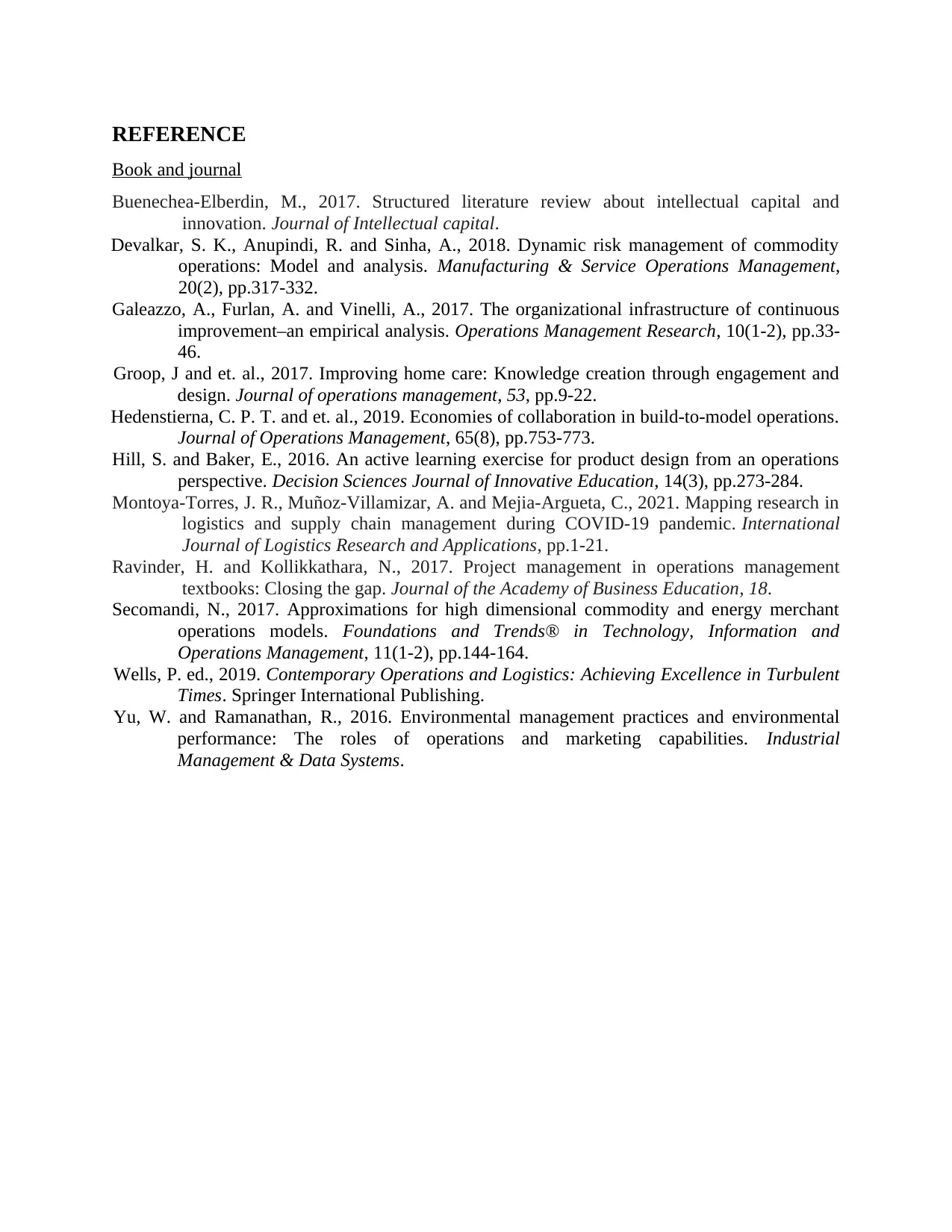
REFERENCE
Book and journal
Buenechea-Elberdin, M., 2017. Structured literature review about intellectual capital and
innovation. Journal of Intellectual capital.
Devalkar, S. K., Anupindi, R. and Sinha, A., 2018. Dynamic risk management of commodity
operations: Model and analysis. Manufacturing & Service Operations Management,
20(2), pp.317-332.
Galeazzo, A., Furlan, A. and Vinelli, A., 2017. The organizational infrastructure of continuous
improvement–an empirical analysis. Operations Management Research, 10(1-2), pp.33-
46.
Groop, J and et. al., 2017. Improving home care: Knowledge creation through engagement and
design. Journal of operations management, 53, pp.9-22.
Hedenstierna, C. P. T. and et. al., 2019. Economies of collaboration in build‐to‐model operations.
Journal of Operations Management, 65(8), pp.753-773.
Hill, S. and Baker, E., 2016. An active learning exercise for product design from an operations
perspective. Decision Sciences Journal of Innovative Education, 14(3), pp.273-284.
Montoya-Torres, J. R., Muñoz-Villamizar, A. and Mejia-Argueta, C., 2021. Mapping research in
logistics and supply chain management during COVID-19 pandemic. International
Journal of Logistics Research and Applications, pp.1-21.
Ravinder, H. and Kollikkathara, N., 2017. Project management in operations management
textbooks: Closing the gap. Journal of the Academy of Business Education, 18.
Secomandi, N., 2017. Approximations for high dimensional commodity and energy merchant
operations models. Foundations and Trends® in Technology, Information and
Operations Management, 11(1-2), pp.144-164.
Wells, P. ed., 2019. Contemporary Operations and Logistics: Achieving Excellence in Turbulent
Times. Springer International Publishing.
Yu, W. and Ramanathan, R., 2016. Environmental management practices and environmental
performance: The roles of operations and marketing capabilities. Industrial
Management & Data Systems.
Book and journal
Buenechea-Elberdin, M., 2017. Structured literature review about intellectual capital and
innovation. Journal of Intellectual capital.
Devalkar, S. K., Anupindi, R. and Sinha, A., 2018. Dynamic risk management of commodity
operations: Model and analysis. Manufacturing & Service Operations Management,
20(2), pp.317-332.
Galeazzo, A., Furlan, A. and Vinelli, A., 2017. The organizational infrastructure of continuous
improvement–an empirical analysis. Operations Management Research, 10(1-2), pp.33-
46.
Groop, J and et. al., 2017. Improving home care: Knowledge creation through engagement and
design. Journal of operations management, 53, pp.9-22.
Hedenstierna, C. P. T. and et. al., 2019. Economies of collaboration in build‐to‐model operations.
Journal of Operations Management, 65(8), pp.753-773.
Hill, S. and Baker, E., 2016. An active learning exercise for product design from an operations
perspective. Decision Sciences Journal of Innovative Education, 14(3), pp.273-284.
Montoya-Torres, J. R., Muñoz-Villamizar, A. and Mejia-Argueta, C., 2021. Mapping research in
logistics and supply chain management during COVID-19 pandemic. International
Journal of Logistics Research and Applications, pp.1-21.
Ravinder, H. and Kollikkathara, N., 2017. Project management in operations management
textbooks: Closing the gap. Journal of the Academy of Business Education, 18.
Secomandi, N., 2017. Approximations for high dimensional commodity and energy merchant
operations models. Foundations and Trends® in Technology, Information and
Operations Management, 11(1-2), pp.144-164.
Wells, P. ed., 2019. Contemporary Operations and Logistics: Achieving Excellence in Turbulent
Times. Springer International Publishing.
Yu, W. and Ramanathan, R., 2016. Environmental management practices and environmental
performance: The roles of operations and marketing capabilities. Industrial
Management & Data Systems.
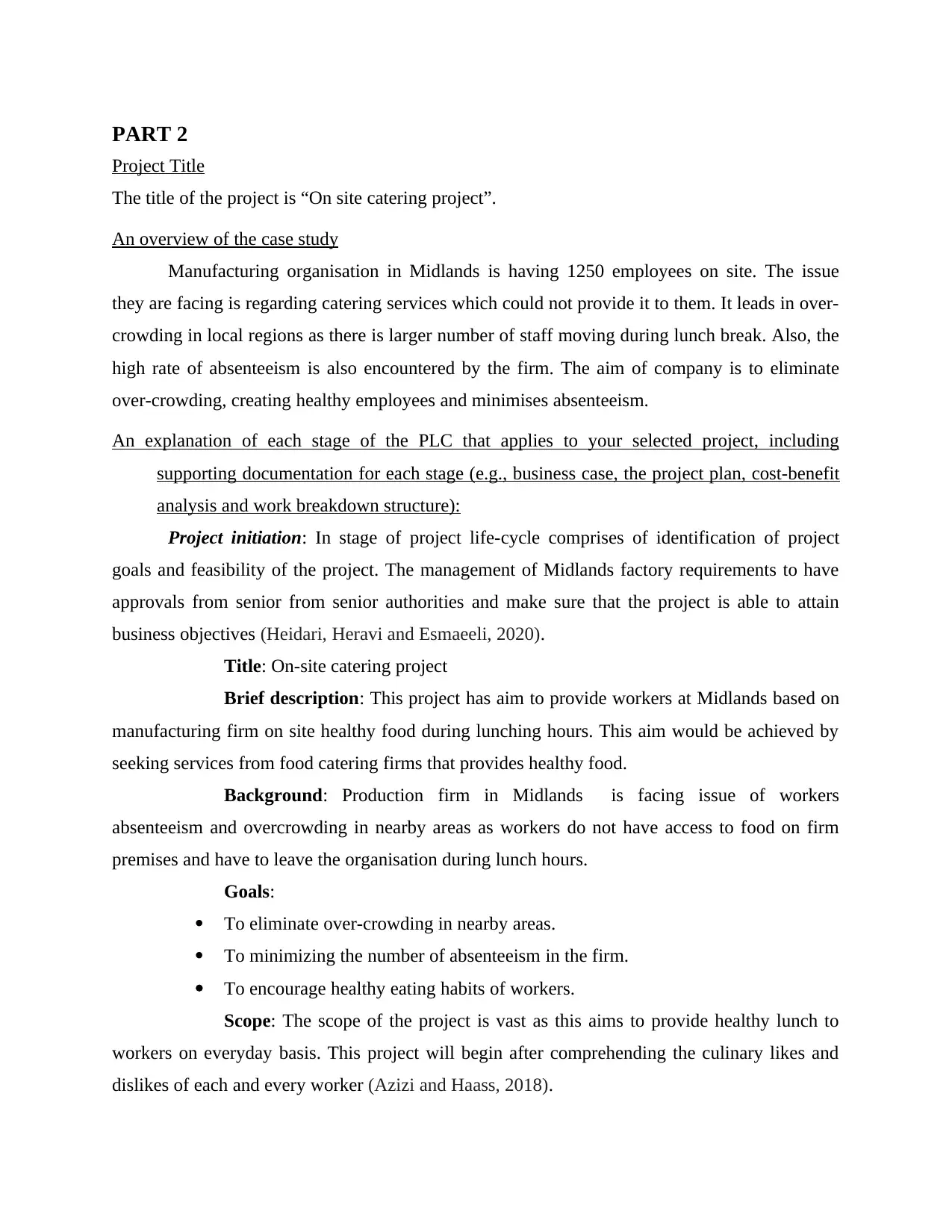
PART 2
Project Title
The title of the project is “On site catering project”.
An overview of the case study
Manufacturing organisation in Midlands is having 1250 employees on site. The issue
they are facing is regarding catering services which could not provide it to them. It leads in over-
crowding in local regions as there is larger number of staff moving during lunch break. Also, the
high rate of absenteeism is also encountered by the firm. The aim of company is to eliminate
over-crowding, creating healthy employees and minimises absenteeism.
An explanation of each stage of the PLC that applies to your selected project, including
supporting documentation for each stage (e.g., business case, the project plan, cost-benefit
analysis and work breakdown structure):
Project initiation: In stage of project life-cycle comprises of identification of project
goals and feasibility of the project. The management of Midlands factory requirements to have
approvals from senior from senior authorities and make sure that the project is able to attain
business objectives (Heidari, Heravi and Esmaeeli, 2020).
Title: On-site catering project
Brief description: This project has aim to provide workers at Midlands based on
manufacturing firm on site healthy food during lunching hours. This aim would be achieved by
seeking services from food catering firms that provides healthy food.
Background: Production firm in Midlands is facing issue of workers
absenteeism and overcrowding in nearby areas as workers do not have access to food on firm
premises and have to leave the organisation during lunch hours.
Goals:
To eliminate over-crowding in nearby areas.
To minimizing the number of absenteeism in the firm.
To encourage healthy eating habits of workers.
Scope: The scope of the project is vast as this aims to provide healthy lunch to
workers on everyday basis. This project will begin after comprehending the culinary likes and
dislikes of each and every worker (Azizi and Haass, 2018).
Project Title
The title of the project is “On site catering project”.
An overview of the case study
Manufacturing organisation in Midlands is having 1250 employees on site. The issue
they are facing is regarding catering services which could not provide it to them. It leads in over-
crowding in local regions as there is larger number of staff moving during lunch break. Also, the
high rate of absenteeism is also encountered by the firm. The aim of company is to eliminate
over-crowding, creating healthy employees and minimises absenteeism.
An explanation of each stage of the PLC that applies to your selected project, including
supporting documentation for each stage (e.g., business case, the project plan, cost-benefit
analysis and work breakdown structure):
Project initiation: In stage of project life-cycle comprises of identification of project
goals and feasibility of the project. The management of Midlands factory requirements to have
approvals from senior from senior authorities and make sure that the project is able to attain
business objectives (Heidari, Heravi and Esmaeeli, 2020).
Title: On-site catering project
Brief description: This project has aim to provide workers at Midlands based on
manufacturing firm on site healthy food during lunching hours. This aim would be achieved by
seeking services from food catering firms that provides healthy food.
Background: Production firm in Midlands is facing issue of workers
absenteeism and overcrowding in nearby areas as workers do not have access to food on firm
premises and have to leave the organisation during lunch hours.
Goals:
To eliminate over-crowding in nearby areas.
To minimizing the number of absenteeism in the firm.
To encourage healthy eating habits of workers.
Scope: The scope of the project is vast as this aims to provide healthy lunch to
workers on everyday basis. This project will begin after comprehending the culinary likes and
dislikes of each and every worker (Azizi and Haass, 2018).
⊘ This is a preview!⊘
Do you want full access?
Subscribe today to unlock all pages.

Trusted by 1+ million students worldwide
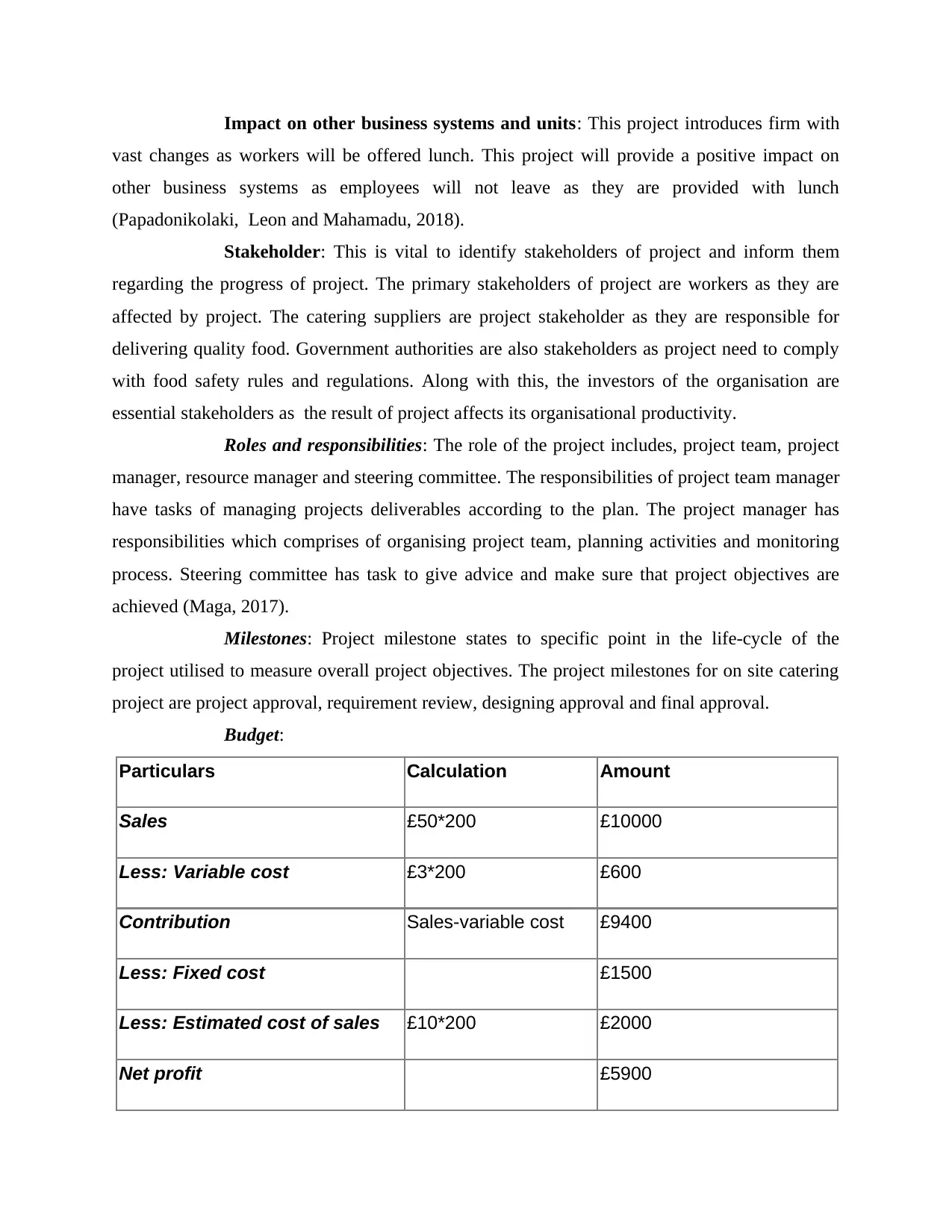
Impact on other business systems and units: This project introduces firm with
vast changes as workers will be offered lunch. This project will provide a positive impact on
other business systems as employees will not leave as they are provided with lunch
(Papadonikolaki, Leon and Mahamadu, 2018).
Stakeholder: This is vital to identify stakeholders of project and inform them
regarding the progress of project. The primary stakeholders of project are workers as they are
affected by project. The catering suppliers are project stakeholder as they are responsible for
delivering quality food. Government authorities are also stakeholders as project need to comply
with food safety rules and regulations. Along with this, the investors of the organisation are
essential stakeholders as the result of project affects its organisational productivity.
Roles and responsibilities: The role of the project includes, project team, project
manager, resource manager and steering committee. The responsibilities of project team manager
have tasks of managing projects deliverables according to the plan. The project manager has
responsibilities which comprises of organising project team, planning activities and monitoring
process. Steering committee has task to give advice and make sure that project objectives are
achieved (Maga, 2017).
Milestones: Project milestone states to specific point in the life-cycle of the
project utilised to measure overall project objectives. The project milestones for on site catering
project are project approval, requirement review, designing approval and final approval.
Budget:
Particulars Calculation Amount
Sales £50*200 £10000
Less: Variable cost £3*200 £600
Contribution Sales-variable cost £9400
Less: Fixed cost £1500
Less: Estimated cost of sales £10*200 £2000
Net profit £5900
vast changes as workers will be offered lunch. This project will provide a positive impact on
other business systems as employees will not leave as they are provided with lunch
(Papadonikolaki, Leon and Mahamadu, 2018).
Stakeholder: This is vital to identify stakeholders of project and inform them
regarding the progress of project. The primary stakeholders of project are workers as they are
affected by project. The catering suppliers are project stakeholder as they are responsible for
delivering quality food. Government authorities are also stakeholders as project need to comply
with food safety rules and regulations. Along with this, the investors of the organisation are
essential stakeholders as the result of project affects its organisational productivity.
Roles and responsibilities: The role of the project includes, project team, project
manager, resource manager and steering committee. The responsibilities of project team manager
have tasks of managing projects deliverables according to the plan. The project manager has
responsibilities which comprises of organising project team, planning activities and monitoring
process. Steering committee has task to give advice and make sure that project objectives are
achieved (Maga, 2017).
Milestones: Project milestone states to specific point in the life-cycle of the
project utilised to measure overall project objectives. The project milestones for on site catering
project are project approval, requirement review, designing approval and final approval.
Budget:
Particulars Calculation Amount
Sales £50*200 £10000
Less: Variable cost £3*200 £600
Contribution Sales-variable cost £9400
Less: Fixed cost £1500
Less: Estimated cost of sales £10*200 £2000
Net profit £5900
Paraphrase This Document
Need a fresh take? Get an instant paraphrase of this document with our AI Paraphraser
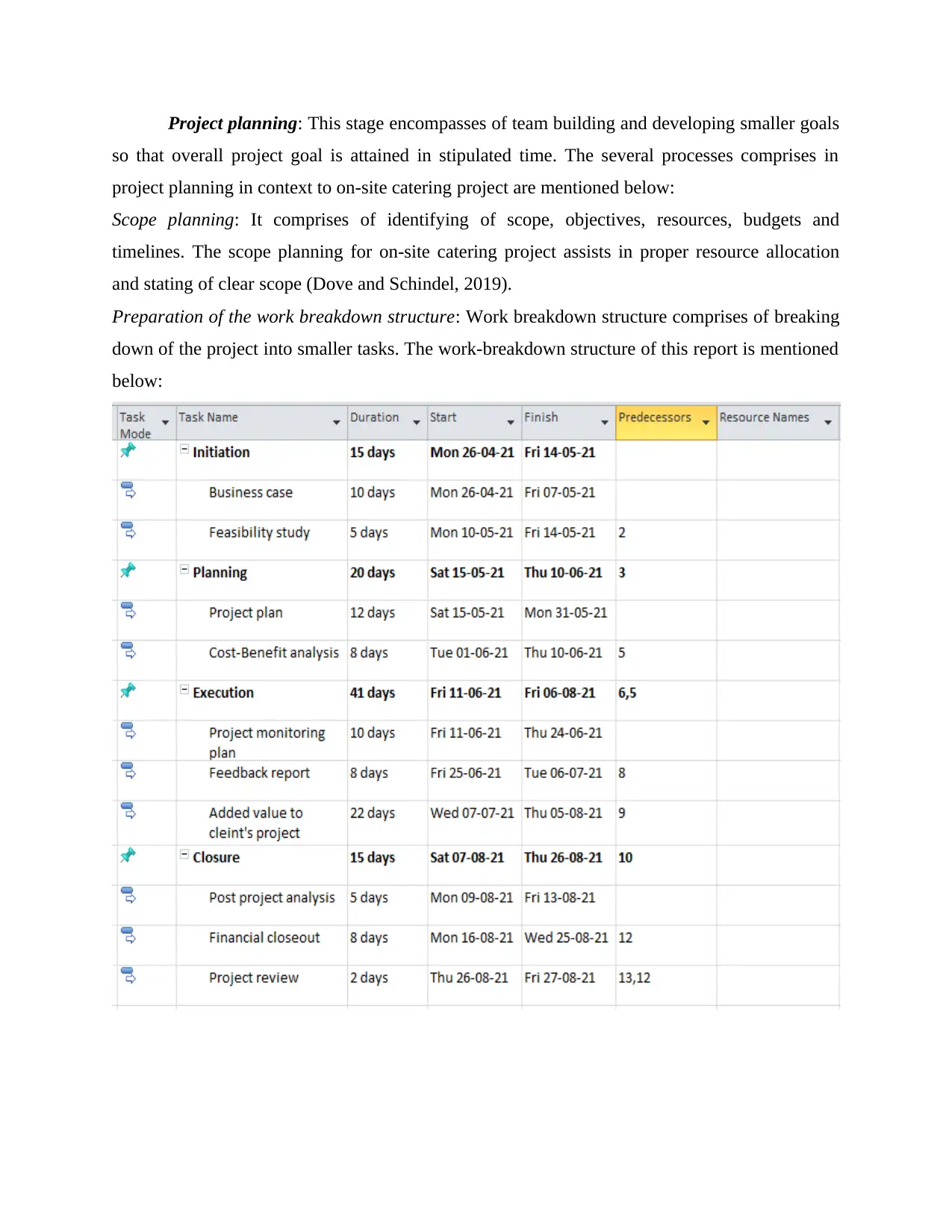
Project planning: This stage encompasses of team building and developing smaller goals
so that overall project goal is attained in stipulated time. The several processes comprises in
project planning in context to on-site catering project are mentioned below:
Scope planning: It comprises of identifying of scope, objectives, resources, budgets and
timelines. The scope planning for on-site catering project assists in proper resource allocation
and stating of clear scope (Dove and Schindel, 2019).
Preparation of the work breakdown structure: Work breakdown structure comprises of breaking
down of the project into smaller tasks. The work-breakdown structure of this report is mentioned
below:
so that overall project goal is attained in stipulated time. The several processes comprises in
project planning in context to on-site catering project are mentioned below:
Scope planning: It comprises of identifying of scope, objectives, resources, budgets and
timelines. The scope planning for on-site catering project assists in proper resource allocation
and stating of clear scope (Dove and Schindel, 2019).
Preparation of the work breakdown structure: Work breakdown structure comprises of breaking
down of the project into smaller tasks. The work-breakdown structure of this report is mentioned
below:
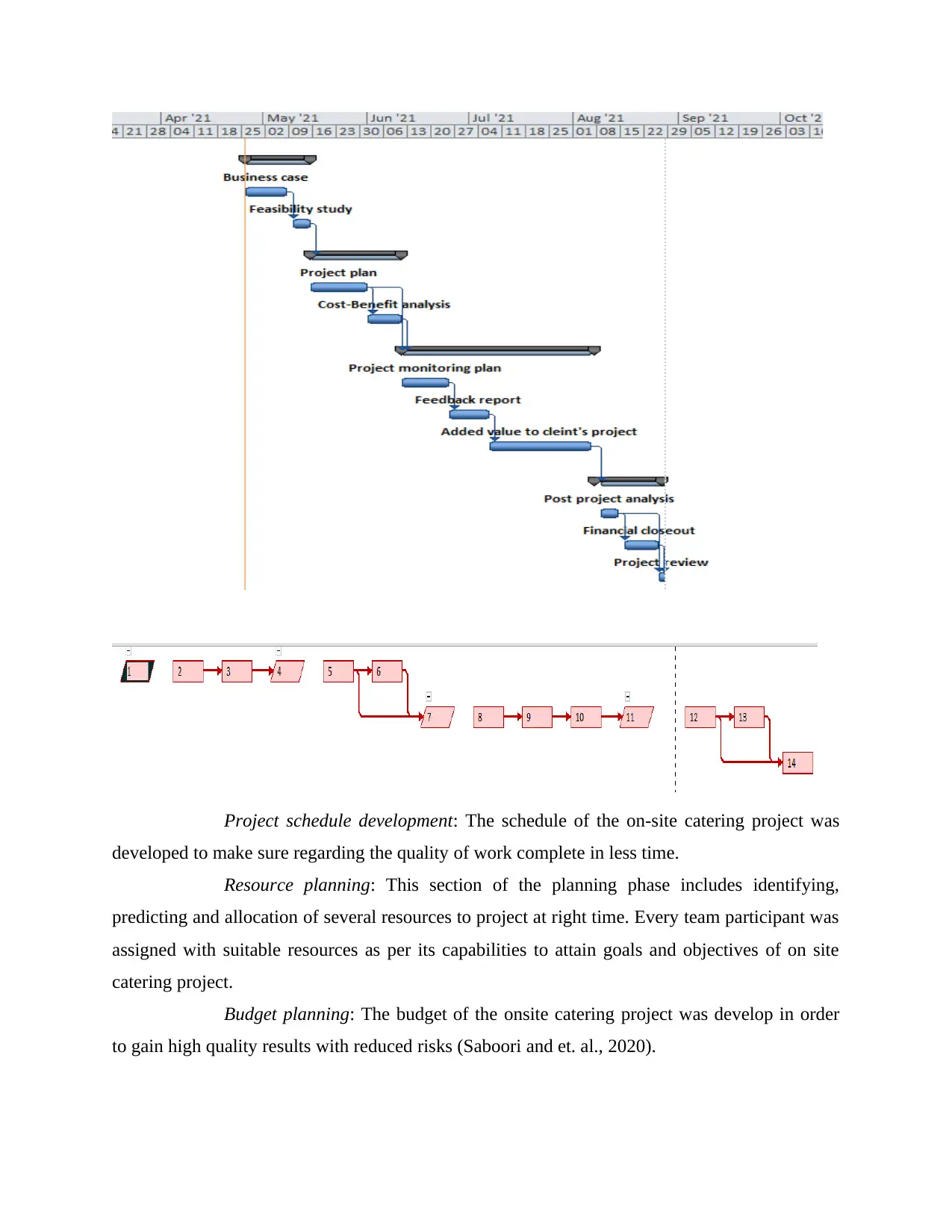
Project schedule development: The schedule of the on-site catering project was
developed to make sure regarding the quality of work complete in less time.
Resource planning: This section of the planning phase includes identifying,
predicting and allocation of several resources to project at right time. Every team participant was
assigned with suitable resources as per its capabilities to attain goals and objectives of on site
catering project.
Budget planning: The budget of the onsite catering project was develop in order
to gain high quality results with reduced risks (Saboori and et. al., 2020).
developed to make sure regarding the quality of work complete in less time.
Resource planning: This section of the planning phase includes identifying,
predicting and allocation of several resources to project at right time. Every team participant was
assigned with suitable resources as per its capabilities to attain goals and objectives of on site
catering project.
Budget planning: The budget of the onsite catering project was develop in order
to gain high quality results with reduced risks (Saboori and et. al., 2020).
⊘ This is a preview!⊘
Do you want full access?
Subscribe today to unlock all pages.

Trusted by 1+ million students worldwide
1 out of 21
Related Documents
Your All-in-One AI-Powered Toolkit for Academic Success.
+13062052269
info@desklib.com
Available 24*7 on WhatsApp / Email
![[object Object]](/_next/static/media/star-bottom.7253800d.svg)
Unlock your academic potential
Copyright © 2020–2025 A2Z Services. All Rights Reserved. Developed and managed by ZUCOL.



